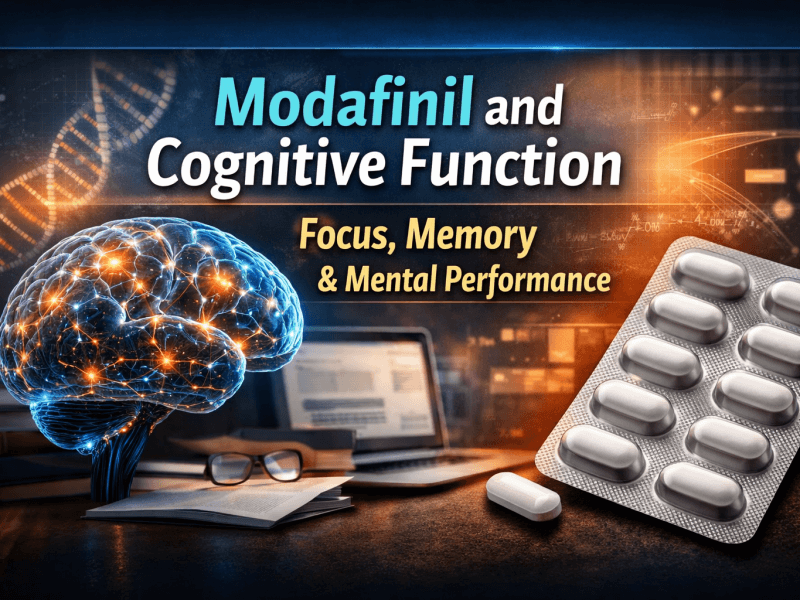Modafinil, a popular eugeroic drug primarily prescribed for narcolepsy, sleep apnea, and shift work sleep disorder, is often used off-label to enhance cognitive performance and alertness. While its stimulating properties can be beneficial in various clinical and non-clinical contexts, long-term use or sudden discontinuation may lead to modafinil withdrawal syndrome, a phenomenon less discussed but crucial for both users and healthcare providers.
What Is Modafinil Withdrawal Syndrome?
Modafinil withdrawal syndrome refers to a collection of physical and psychological symptoms that may occur after stopping or reducing the dose of modafinil, particularly after prolonged or excessive use. Unlike classical stimulants such as amphetamine or methylphenidate, modafinil is often regarded as having a lower abuse potential. However, evidence and user reports increasingly point toward dependence-like behavior and withdrawal symptoms in some individuals.
Is Modafinil Addictive?
Although not classified as a classic addictive stimulant, modafinil interacts with the dopaminergic system by inhibiting dopamine reuptake, particularly at the dopamine transporter (DAT). Over time, this mechanism may lead to tolerance, psychological reliance, and eventual withdrawal upon cessation. Users may find themselves increasing the dose or relying on the drug to maintain performance levels, further solidifying the cycle of dependency.
Common Symptoms of Modafinil Withdrawal
Symptoms of modafinil withdrawal can vary widely depending on the duration of use, dosage, and individual physiology. Some users report mild symptoms, while others experience debilitating effects. The most common symptoms include:
- Excessive fatigue and drowsiness
- Depressed mood or anhedonia
- Brain fog or cognitive slowing
- Anxiety or restlessness
- Irritability and mood swings
- Lack of motivation
- Headaches
- Sleep disturbances or hypersomnia
These symptoms may last from a few days to several weeks, particularly if the user has taken high doses over a long period.
The Science Behind Modafinil Withdrawal
Modafinil action primarily targets the hypothalamus, locus coeruleus, and other arousal-related brain regions. By enhancing histamine, orexin, dopamine, and norepinephrine levels, it promotes prolonged wakefulness. When discontinued, the sudden absence of these neurochemical elevations leads to a rebound effect, manifesting as drowsiness, fatigue, and low motivation.
Moreover, dopamine downregulation from chronic use may cause temporary dysfunction in reward pathways, contributing to emotional blunting and anhedonia during withdrawal.
Who Is at Risk for Modafinil Withdrawal?
While not everyone experiences withdrawal, several groups may be at elevated risk:
- Long-term users (6+ months)
- High-dose users (above 200mg daily)
- Individuals using modafinil for non-medical reasons, such as productivity enhancement or studying
- People with a history of substance use disorders
- Those with underlying psychiatric conditions, particularly depression and anxiety
Understanding these risk factors helps tailor tapering strategies and monitor for emerging withdrawal signs.
Tapering Off Modafinil Safely
Suddenly stopping modafinil may precipitate more intense withdrawal symptoms. Instead, a gradual tapering protocol is advisable:
- Reduce the dose by 25-50 mg every few days depending on tolerance.
- Monitor mood, energy levels, and sleep quality during the process.
- Maintain a regular sleep schedule to naturally reestablish circadian rhythms.
- Supplement with adaptogens or nootropics (e.g., L-theanine, Rhodiola Rosea) under supervision to ease the transition.
Consulting a healthcare professional before discontinuing is essential, especially for those using modafinil therapeutically.
How Long Does Modafinil Withdrawal Last?
The acute withdrawal phase typically lasts 3-10 days, characterized by extreme fatigue, low mood, and mental fog. However, post-acute withdrawal syndrome (PAWS) may persist for weeks, particularly in users with underlying dopamine imbalances or those who took modafinil inconsistently at high doses.
During this time, individuals may feel unmotivated, mentally sluggish, and emotionally flattened. Supportive care and lifestyle modifications are crucial for recovery.
Psychological Aspects of Modafinil Withdrawal
Beyond physical symptoms, psychological effects can be profound. Many users report:
- Anxiety about productivity loss
- Fear of regressing to pre-modafinil cognitive performance
Such concerns may lead to relapse, especially if individuals are unaware of supportive strategies or lack professional guidance. Mental health counseling, mindfulness practices, and cognitive-behavioral techniques can provide effective tools for managing the transition.
Alternative Strategies for Managing Fatigue Post-Modafinil
For users seeking to discontinue modafinil without falling into fatigue and poor focus, several lifestyle and nutritional interventions may help:
- Sleep hygiene: Avoid screens before bed, maintain regular bedtimes
- Exercise: Regular aerobic activity improves alertness naturally
- Diet: High-protein, low-sugar diets stabilize energy
- Caffeine alternatives: Green tea, matcha, and yerba mate offer a gentler stimulant effect
- Nootropic stacks: Certain blends of L-tyrosine, citicoline, or ashwagandha may offer cognitive support without triggering dependence
When to Seek Professional Help
If withdrawal symptoms are severe, prolonged, or significantly interfere with daily functioning, it’s crucial to consult a qualified medical professional. Modafinil withdrawal syndrome is manageable, but ignoring its psychological or neurological dimensions can prolong suffering and complicate recovery.
Signs that warrant medical attention include:
- Persistent depression or suicidal thoughts
- Inability to perform basic daily activities
- Intense cravings or urges to relapse
- Co-occurring substance abuse issues
Conclusion
While modafinil is often celebrated for its wake-promoting and cognitive-enhancing benefits, users must be aware of the potential withdrawal syndrome that can accompany abrupt discontinuation, particularly after long-term use. Understanding the symptoms, implementing safe tapering protocols, and seeking supportive strategies are key to navigating the modafinil withdrawal process successfully.
‼️ Disclaimer: The information provided in this article about modafinil is intended for informational purposes only and is not a substitute for professional medical consultation or recommendations. The author of the article are not responsible for any errors, omissions, or actions based on the information provided.
References:
- U.S. Food and Drug Administration. PROVIGIL. U.S. Department of Health and Human Services. https://www.accessdata.fda.gov/drugsatfda_docs/label/2015/020717s037s038lbl.pdf . 2015
- Lewis, J. E. The effects of twenty-one nutrients and phytonutrients on cognitive function: A narrative review. https://doi.org/10.18053/jctres.07.202104.014 . 2021
- Willavize, S. A., Nichols, A. I., & Lee, J. Population pharmacokinetic modeling of modafinil and its major metabolites. https://doi.org/10.1002/jcph.800 . 2016
- Fuxe K, et al. Modafinil enhances the increase of extracellular serotonin levels induced by the antidepressant drugs fluoxetine and imipramine: a dual probe microdialysis study in awake rat. Synapse. 2005
- Mechanisms of modafinil: A review of current research. nih.gov. 2007
- PROVIGIL (modafinil) Tablets. FDA.GOV. 2010
- Oliva Ramirez A, Keenan A, Kalau O, Worthington E, Cohen L, Singh S. Prevalence and burden of multiple sclerosis-related fatigue: a systematic literature review. 2021.
- Ciancio A, Moretti MC, Natale A, Rodolico A, Signorelli MS, Petralia A. Personality Traits and Fatigue in Multiple Sclerosis: A Narrative Review. Journal of Clinical Medicine. 2023
- Mereu, M., Bonci, A., Newman, A. H., & Tanda, G. The neurobiology of modafinil as an enhancer of cognitive performance and a potential treatment for substance use disorders. https://doi.org/10.1007/s00213-013-3232-4 . 2013
- Ishizuka, T., Murotani, T., Yamatodani, A. (2010). Modafinil activates the histaminergic system through the orexinergic neurons. DOI: 10.1016/j.neulet.2010.08.005 . 2010


